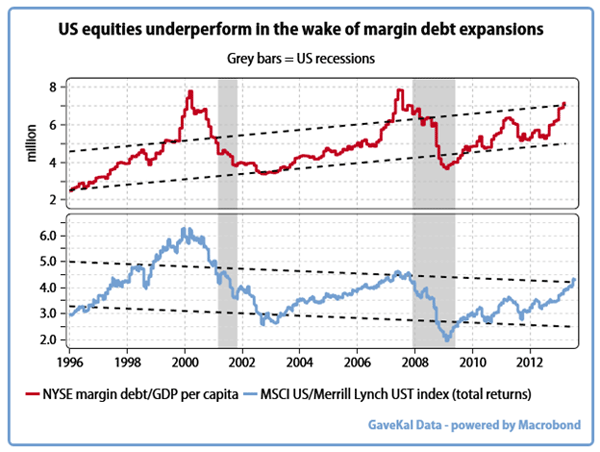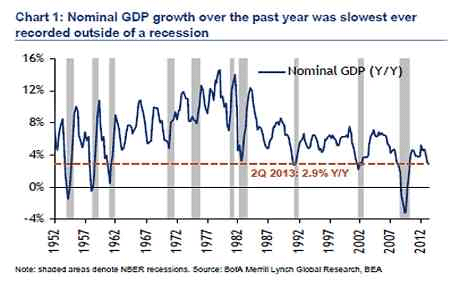It may seem like we are constantly beating the drum of a top in the market with recent articles like the NASDAQ ROC stock commentary , Obama’s Comments Worry Stock Bulls and today’s Signs of the Top, but each of these articles was developed separately by different authors from different points of view although Beware of Bears was written by the same author as one of the others. In today’s article John Mauldin pulls together evidence that the overheated equities market may be about to stall. ~Tim McMahon, editor
Signs of the Top
By John Mauldin
We are told they don’t ring a bell when bull or bear markets start. That may be true, but it does seem that there are similar signs as we approach turning points. This week in my reading I have been struck by a number of signs that suggest that, if we haven’t reached a top in the latest bull market cycle, at least a pause may be in order. Let’s review a few of them. The first comes from Charles Gave, who notes that margin debt is now back to extremes.
I started in the fascinating business of trying to understand why markets go up and down in February 1971. The old money manager in the French bank which had hired me straightaway said: “Charles, you will never get rich in this business using other people’s money. Do NOT leverage your positions. Leverage might be all right for fellows who deal in real estate, but for those in stock markets, it only brings misery.”
Being young and smart (or so I thought), I assumed this advice could not conceivably apply to me. A few margin calls later, accompanied by quite a string of sleepless nights, and I came to realize that the old gentleman had a point.
Now that I am quite old myself and certainly not as smart as I thought I was in 1971, I find myself tracking the moves of the poor souls who believe they can leverage profitably. Then I do the opposite. This is why Charles the 70-year-old is watching what Charles the 30-year-old is doing—to do the reverse. Have a look at the graph.

The red line at the top is New York Stock Exchange margin debt as a multiple of US GDP per capita, the black line on the bottom pane is a ratio between US stocks and (government) bonds. It seems that the fellows using other people’s money to get rich have an uncanny ability to leverage up when shares become overvalued vs. bonds. They also seem to get most enthusiastic just before a recession, usually after a prolonged outperformance of equities against bonds.
They leverage in order to participate as much as possible in what looks like a free ride, with no downside risk. There are always a number of good reasons why the stock market cannot change direction. Take your pick: “technology has created a new type of economy,” or “house prices never go down,” or “we have recently discovered an infinite source of wealth called QE.” These reasons can be added to a long roster of other excuses such as, “I can get insurance against the next market decline” (1987) or “the Fed will never, ever allow for positive real rates to appear” (1979) or “oil prices cannot quadruple” (1974).
The rise in the stock market this past year has not been because of fundamentals. Earnings in the nonfinancial sector have been flat. Mark Gongloff writes on the HuffPost site:
Bloomberg figures that bank earnings rose 27% in the second quarter, which was the only thing keeping the S&P 500 from reporting a net drop in profits for the quarter. With the banks, S&P 500 profits were up 3.3% in the quarter, Bloomberg estimates. Without them, S&P 500 profits would have been down 1.2%.
Lousy profits have not kept the S&P 500 from gaining nearly 19 percent so far this year. But even that performance trails the financial sector, which is up 26 percent this year. The banks topped the broader market last year, too, doubling the broader market’s gain. And banks have managed all this despite never-ending scandals, onerous regulations and the scorn of an angry nation.
The Wall Street Journal suggests that non-financial companies might have finally reached the limit of how much profit they can squeeze out of a dour economy by laying off workers and cutting costs. Banks, on the other hand, have the useful ability to skim rent from even the lamest economy. They’re proving it now and finding profits in innovative ways, like moving aluminum around in warehouses to create a sense of scarcity and drive up prices.” (Huffington Post)
This lack of profits is showing up in the economy. Nominal GDP growth over the past year was the slowest ever recorded outside of a recession, as the following chart from the London Telegraph demonstrates.

And because the rise in the stock market has not been accompanied by an increase in earnings, price-to-earnings ratios have risen back to levels that suggest the market is getting closer to stalling out. I post the following tables from the Wall Street Journal. While the Dow and the S&P 500 are not at nosebleed levels, they are certainly pricey. The Russell 2000 and the NASDAQ, on the other hand, are seriously overpriced in terms of earnings.
To continue reading this article from Thoughts from the Frontline – a free weekly publication by John Mauldin, renowned financial expert, best-selling author, and Chairman of Mauldin Economics – please click here.
© 2013 Mauldin Economics. All Rights Reserved.
Thoughts from the Frontline is a free weekly economic e-letter by best-selling author and renowned financial expert, John Mauldin. You can learn more and get your free subscription by visiting www.MauldinEconomics.com.
